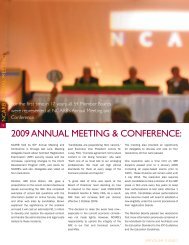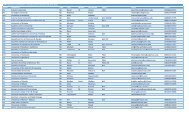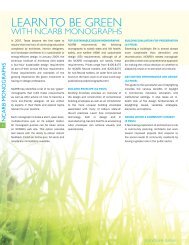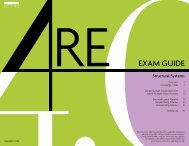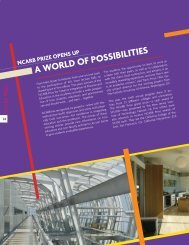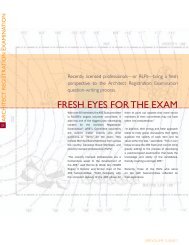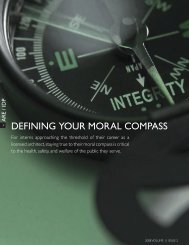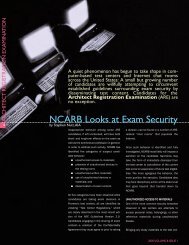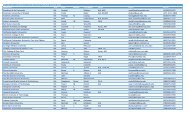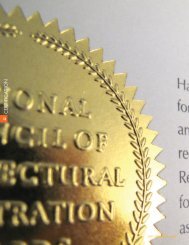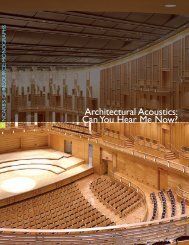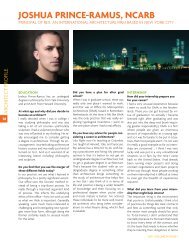Model Brief to Enforce Laws Prohibiting Architectural ... - NCARB
Model Brief to Enforce Laws Prohibiting Architectural ... - NCARB
Model Brief to Enforce Laws Prohibiting Architectural ... - NCARB
You also want an ePaper? Increase the reach of your titles
YUMPU automatically turns print PDFs into web optimized ePapers that Google loves.
<strong>Model</strong> <strong>Brief</strong><br />
ingly issue, just as injunctions have issued in other cases involving unlicensed<br />
persons engaged in the practice of architecture and landscape design. See,<br />
e.g., State ex rel. Mo. Bd. for Architects, Prof’l Engineers and Land Surveyors v.<br />
Henigman, 937 S.W.2d 757, 759 (1997) (injunction properly issues where<br />
defendant practiced architecture without holding a valid certificate of registration<br />
<strong>to</strong> practice architecture); State of South Carolina ex rel. Love v. Howell, 281<br />
S.C. 463, 316 S.E.2d 381 (1984) (injunction properly issues where defendant<br />
consulted with clients, determined their needs, viewed their property and<br />
prepared architectural plans, but was not licensed under statute); State of New<br />
Jersey Board of Architects v. North, 197 N.J. Super 349 484 A.2d 1297, 1299<br />
(1984) (injunction properly issues where defendant gathered structural data<br />
and prepared detailed drawings for construction, but was not licensed under<br />
the statute); State Board of Architecture v. Kirkham, Michael & Assoc., Inc., 179<br />
N.W.2d 409 (N.D. 1970) (injunction properly issues against false advertising<br />
that corporation is authorized <strong>to</strong> practice architecture where corporation identifies<br />
itself as a firm of architects and engineers on its letterhead, on plans and<br />
specifications that it prepares and in its advertising, but a corporation may not<br />
be licensed <strong>to</strong> practice under the terms of the architectural registration statute);<br />
Hopping v. Louisiana Horticulture Comm’n, 509 So.2d 751 (La. App. 1st Cir.<br />
1987) (upholding Board’s cease and desist order where unlicensed landscape<br />
designer prepared preliminary site plans and represented himself as a “landscape<br />
designer” on letterhead and checking account).<br />
B. The threat of irreparable harm <strong>to</strong> the public supports injunctive relief.<br />
The [<strong>Model</strong> Law] is regula<strong>to</strong>ry legislation aimed at protecting the public from the<br />
risks that are inherent when individuals who are unwilling or unable <strong>to</strong> demonstrate<br />
their competence through the prescribed professional licensing process design<br />
buildings that human beings will inhabit. See [cite <strong>to</strong> any helpful language in the<br />
state statute or local case law]; see generally State Bd. of Architects v. Clark, 114<br />
Md. App. 247, 260, 689 A.2d 1247, 1254 (1997) (purpose of statute preventing<br />
unlicensed practice of architecture is <strong>to</strong> “safeguard life, health, public safety, and<br />
property and <strong>to</strong> promote the public welfare,” quoting Maryland Architects Act §<br />
3-102); Gallagher v. Leary, 164 Vt. 633, 634, 674 A.2d 787, 788 (1996) (holding<br />
that statute preventing unlicensed practice of architecture is intended “<strong>to</strong> protect<br />
the public from unqualified practitioners”); Marshall-Schule v. Goldman, 137 Misc.<br />
2d 1024, 1029, 523 N.Y.S.2d 16 (1987) (“The profession of architecture involves<br />
‘the safety and lives of the general public’”) (citation omitted); Rolls v. Bliss &<br />
Nyitray, Inc., 408 So.2d 229, 235 (Fla. App. 1982), app. dismissed without opin.<br />
415 So.2d 1359 (Fla. 1982) (statute preventing unlicensed practice states that “the<br />
Legislature finds that improper design and improper construction supervision by<br />
architects of buildings principally designed for human habitation or use present a<br />
significant threat <strong>to</strong> the public”); White Co. v. LeClair, 25 Mich. App. 562, 564,<br />
181 N.W.2d 790 (1970) (purpose of statute preventing unlicensed practice of<br />
architecture is <strong>to</strong> “safeguard public life, health and property”).<br />
5



